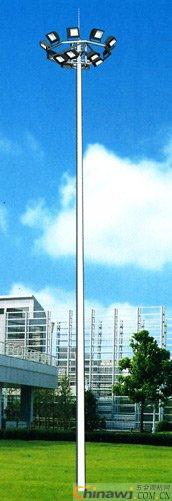High pole lights have gained significant attention and popularity among many companies. However, there are several challenges in their structural design, lighting creativity, and overall layout, which often cause confusion for users during installation and selection. This article addresses five key issues related to the structure and design of high pole lights and offers practical solutions to enhance performance and safety. The current market is flooded with "naked" street lamps, which are typically designed without any protective casing. While some manufacturers argue that this design improves heat dissipation, it comes with serious drawbacks when exposed to harsh environmental conditions like acid rain, sandstorms, or heavy snowfall.
One major issue is the material's surface treatment. Many of these lamps are made from aluminum alloy, which is lightweight and has good thermal conductivity. However, aluminum is chemically reactive and prone to oxidation. Although anodizing can improve its corrosion resistance, the oxide layer can be easily damaged during installation or over time. Once damaged, the lamp body becomes vulnerable to acid rain, which can accumulate in grooves and corrode the structure. This not only affects the appearance but also reduces heat dissipation efficiency and weakens mechanical strength. Additionally, the open design makes it easier for dust and snow to accumulate on the radiator, further reducing cooling performance and increasing the load on the pole.
Another problem is the rectangular design, which doesn't meet wind resistance standards. A rectangular shape creates large flat surfaces that can catch wind, putting pressure on the pole and its mounting structure. While this may not be a big issue under normal conditions, in areas prone to typhoons or strong winds, the risk of bending or toppling increases significantly.
The heat island effect is another critical concern. In urban areas, where temperatures are higher than surrounding regions, high pole lamps with large radiators can contribute to this phenomenon. If the heat dissipation is inefficient, hot air accumulates in the center, leading to localized overheating. This not only reduces efficiency but also shortens the lifespan of the lamp.
Moreover, the monolithic design of many high pole lights makes maintenance difficult. These lamps are often built as a single unit, making repairs costly and time-consuming. When a failure occurs, the entire lamp must be replaced and sent back to the factory, increasing both cost and downtime.
Lastly, sharp edges on the heat sink pose a safety hazard. These edges can damage the surface treatment process, making it harder to apply coatings evenly. More importantly, they can injure workers during installation or maintenance, especially when working at height.
To address these issues, the author suggests adding a streamlined cover to protect the heat sink while maintaining efficient airflow. This cover should be designed with proper ventilation and flow guidance to reduce UV exposure, prevent acid rain accumulation, minimize dust and snow buildup, and distribute wind pressure more evenly. For better maintenance, modular designs are recommended instead of monolithic structures. Finally, lighting engineers should consider user experience and incorporate local culture into their designs to create more appealing and functional products.
In conclusion, improving the design and structure of high pole lights requires a balance between aesthetics, functionality, and safety. As the industry becomes more competitive, focusing on quality, innovation, and user-centered design will be essential for long-term success.
Source:

Polished Chrome Finish is the most popular finish for kitchen faucets, this shiny finish is perfect for anyone who wants their faucet to stand out. Durable and easy to clean, it will match any other fixture in your kitchen. Moreover, chrome faucets are cheaper than other color faucets and are the first choice of many consumers. Secondly, its easy maintenance is also a plus point. If you have no specific requirements for color, then we definitely recommend chrome Kitchen Faucets first, which is also the choice of most families. Chrome color can be highly matched with any style of kitchen decoration.
Chrome Kitchen Sink Faucet, Mixer Kitchen Tap Chrome, Tap For Kitchen Sink Chrome, Chrome Swan Neck Tap, Chrome Kitchen Mixer Tap
Kaiping Jianfa Sanitary Ware Co.,Ltd. , https://www.jfsanitary.com